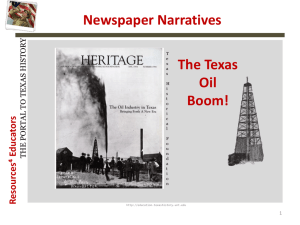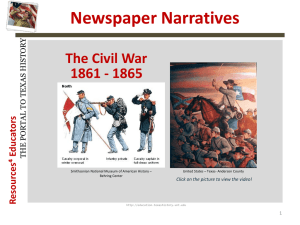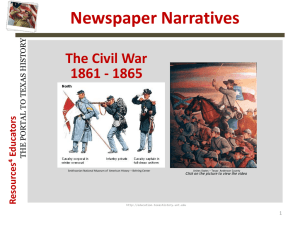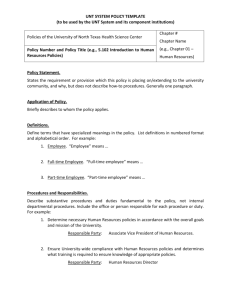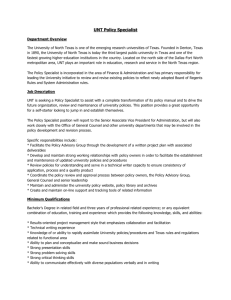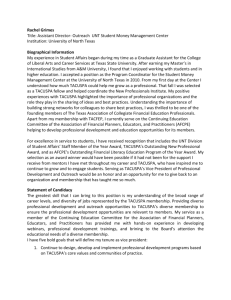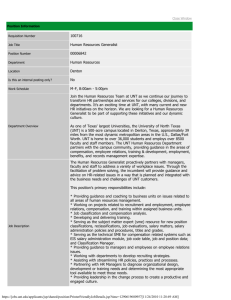PowerPoint - Resources 4 Educators
advertisement
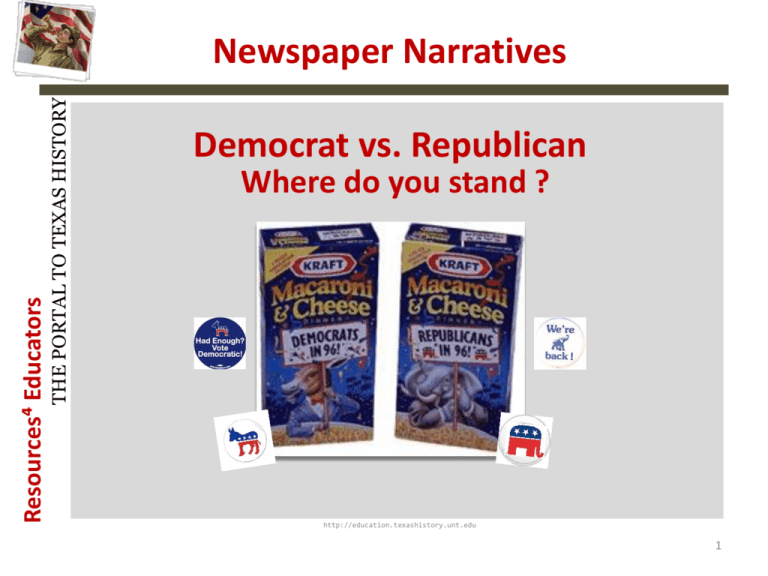
THE PORTAL TO TEXAS HISTORY Resources⁴ Educators Newspaper Narratives Democrat vs. Republican Where do you stand ? http://education.texashistory.unt.edu 1 THE PORTAL TO TEXAS HISTORY Resources⁴ Educators Students will view online newspapers to learn about elections and political campaigns. They will follow the permalinks embedded on each slide, as well as use the “elections” worksheet, among others. Discover the numerous links embedded within this PowerPoint, you may select a few slides to use or have students view just the slide show. How to view the articles: 1. Students use the slides_with_notes PowerPoint. 2. From the slide, click on the picture or buttons. 3. Then click on the zoom link, located on the right side of the page. 4. Locate and read the article. (download to read) http://education.texashistory.unt.edu 2 THE PORTAL TO TEXAS HISTORY Resources⁴ Educators Vocabulary What is a political party? A political party is a group of citizens who agree on a major issue, they work to create public policy to make changes to support their point of views. Parties choose or nominate, people they want to elect for public office. These candidates campaign to get elected. • • • • • • • • • • • • • General Election Party Platform Secret Ballot Incumbent Republican Democrat Coalition Third Party Conservative Liberal Primary Election Electoral College Popular Vote http://education.texashistory.unt.edu 3 THE PORTAL TO TEXAS HISTORY Resources⁴ Educators The Two-party System The United States has a twoparty system. The Republicans in 1860 emerged as a major party with the election of Abraham Lincoln. Abraham Lincoln The Democratic Party formed under Andrew Click on the star to learn Jackson in 1828. more Andrew Jackson Any American citizen may join a political party, but most members are 18 years or older. http://education.texashistory.unt.edu 4 THE PORTAL TO TEXAS HISTORY Resources⁴ Educators Political Parties in the U.S. Hamilton vs. Jefferson Thomas Jefferson Click on the star to learn about him. Disagreement over major issues on the Constitution and government led to the emergence of political parties. Alexander Hamilton Click on the star to learn about him. Jefferson’s group took the name of democraticrepublicans and wanted the states to hold greater power. They feared a powerful central government. Hamilton’s followers called themselves federalists. They supported the Constitution and advocated for a strong national government with a powerful chief executive. http://education.texashistory.unt.edu 5 THE PORTAL TO TEXAS HISTORY Resources⁴ Educators The Two Parties Emerge Jacksonian Democracy Reigns Andrew Jackson Click on the star to learn more about his life. In 1828, the farmers and small business owners who made up Jefferson’s party, calling themselves the Democratic Party, nominated Andrew Jackson. He stood for the common citizen, but looked out for southern and western interests. Those who did not support Jackson formed their own party called Whigs, after a Scottish political leader. Their real name was the National Republican Party. http://education.texashistory.unt.edu 6 THE PORTAL TO TEXAS HISTORY Resources⁴ Educators The Two Major Parties For two decades the Whigs and Democrats made up the two key parties. In 1854, Whigs former Free Soil Party members, and ex-Democrats formed the Republican Party to oppose the spread of slavery in U.S. territories. The Whigs faded from American politics leaving the Democrats and Republicans in a two-party system that has dominated American politics ever since. Use the “Elections” worksheet! Click on the stars to find out more! http://education.texashistory.unt.edu 7 THE PORTAL TO TEXAS HISTORY Resources⁴ Educators Third Parties A “third party” is a party other than the two major parties. These smaller groups challenge the major parties and can change the outcome of an election. None have ever gained control of the White House as the odds are against them. Sometimes, a third party will win seats in Congress or gain office in lower levels of government. Their most important role is to influence policy on one or more. http://education.texashistory.unt.edu 8 THE PORTAL TO TEXAS HISTORY Resources⁴ Educators The Odds Are Against Them The Socialist and Communist Parties want to nationalize major industries. The Green Party calls for companies to respect the environment. Click on the picture Third-party candidates must get voter signatures in order to be placed on the ballot for national office. http://education.texashistory.unt.edu 9 THE PORTAL TO TEXAS HISTORY Resources⁴ Educators At the turn of the Century In the late 1800s, the People’s Party, or “Populists” became popular. They had the support of farmers and workers who called for better working conditions. They never succeeded in getting a national candidate into office. Many of their ideas on workers’ rights later became laws in the 20th century. Click on the picture http://education.texashistory.unt.edu 10 THE PORTAL TO TEXAS HISTORY Resources⁴ Educators The Republican Split Former Republican President Theodore Roosevelt left the Republican Party and was nominated by the Progressive Party. It was nicknamed the “Bull Moose Party” because TR said he was “fit as a Bull Moose”. He split the 1912 Republican vote allowing Democrat Woodrow Wilson to defeat President William H. Taft. Bull Moose’s attempt to influence the Republican Convention in Chicago. Click on the star to view: zoom in to read the print at the bottom of the newspaper. http://education.texashistory.unt.edu 11 THE PORTAL TO TEXAS HISTORY Resources⁴ Educators The Electoral Process Each state has as many electors as it has members in the U. S. Senate and House of Representatives combined. One for each of the 435 members of the House, plus one for each of the 100 senators. Three electors represent the District of Columbia for a total of 538. Many states do not show the name of the electors on the ballot. Voters see only the names of the candidates for president and vice president. What is the Presidential Candidates lucky number? 270 for the answer click on screen Do you know why? click on stars to view breakdown of electoral vote s by state Do “count the votes” math activity. Then complete the “Electoral votes” worksheet! http://education.texashistory.unt.edu 12 THE PORTAL TO TEXAS HISTORY Resources⁴ Educators Politics Today! Democrats usually feel that the federal government has a responsibility to help the poor through government intervention. Democrats are generally seen as liberal. Republicans hold the view that leaving the economy alone will allow for growth, giving people greater ability to help themselves. They believe in less regulation. Republicans are viewed as being conservative. http://education.texashistory.unt.edu 13 THE PORTAL TO TEXAS HISTORY Resources⁴ Educators Democrat or Republican? Use the “Comparing political parties” worksheet. To find out how you stand on the issues! click on the picture to view other campaign cartoons! http://education.texashistory.unt.edu 14

